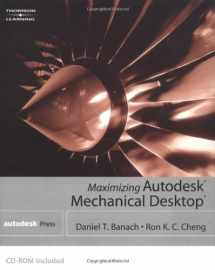
Maximizing Autodesk Mechanical Desktop
Book details
Summary
Description
Gain a first-hand understanding of computer modeling concepts as you discover the secrets of using Mechanical Desktop 6 to construct 3D parametric solid parts, generate assemblies, produce 3D NURBS-based surface models, and output 2D engineering drawings! New from Autodesk Press, Maximizing Autodesk Mechanical Desktop is a "must" for mechanical engineers and engineering students alike. Unlike cookbook-style tutorials, this book propels readers to an understanding of computer-aided design theory while offering in-depth instruction in the whys and hows of using Mechanical Desktop to save time and enhance productivity. The first chapter begins with an overview of computer modeling concepts, explains how 3D objects are represented on computer, and introduces readers to the Mechanical Desktop 6 user interface (including use of the desktop browser). Using carefully engineered examples and exercises, subsequent chapters lead readers through the ins and outs of each of the four Mechanical Desktop modules: part modeling, assembly modeling, surface modeling, and engineering drafting. Instruction in converting AutoCAD solids to Mechanical Desktop solids, editing static base solid features by leveraging AutoCAD solid editing tools, and using the feature exchange add-on is also included to empower readers with the expertise needed to fully exploit the power of their software.


We would LOVE it if you could help us and other readers by reviewing the book
Book review



